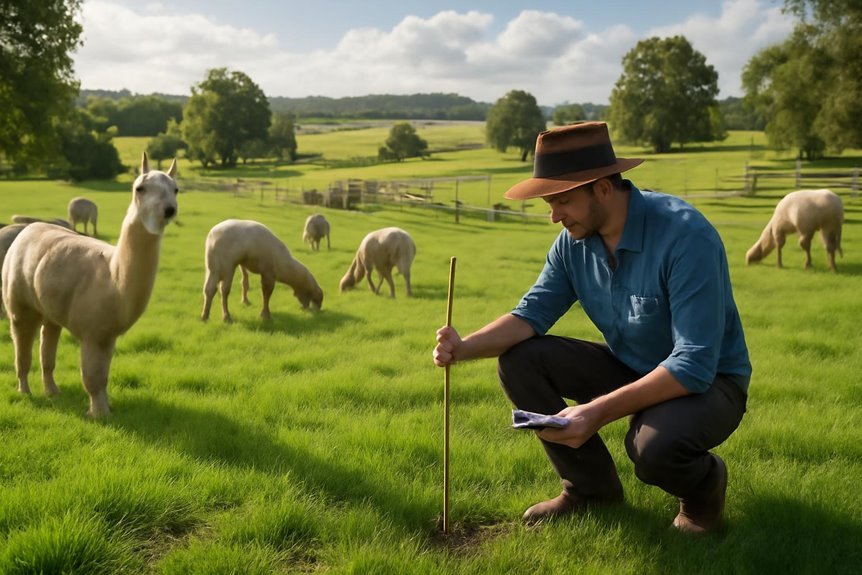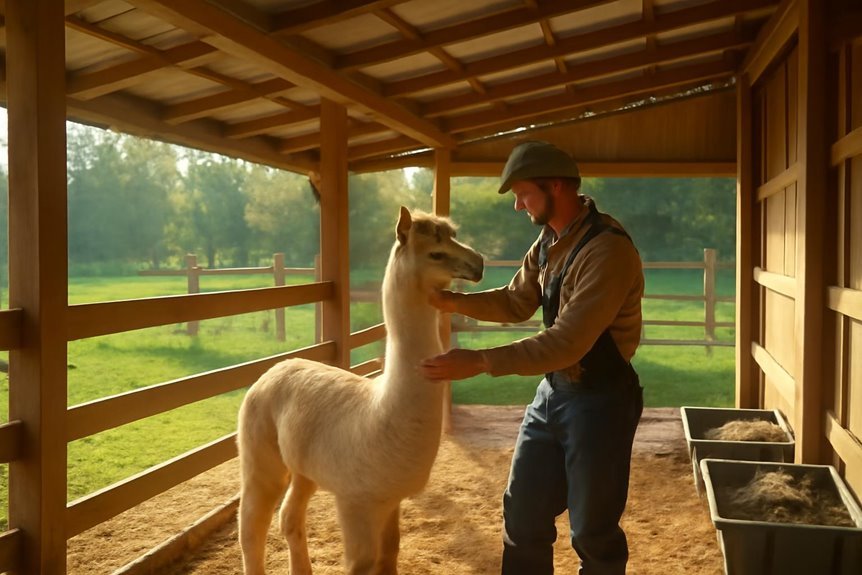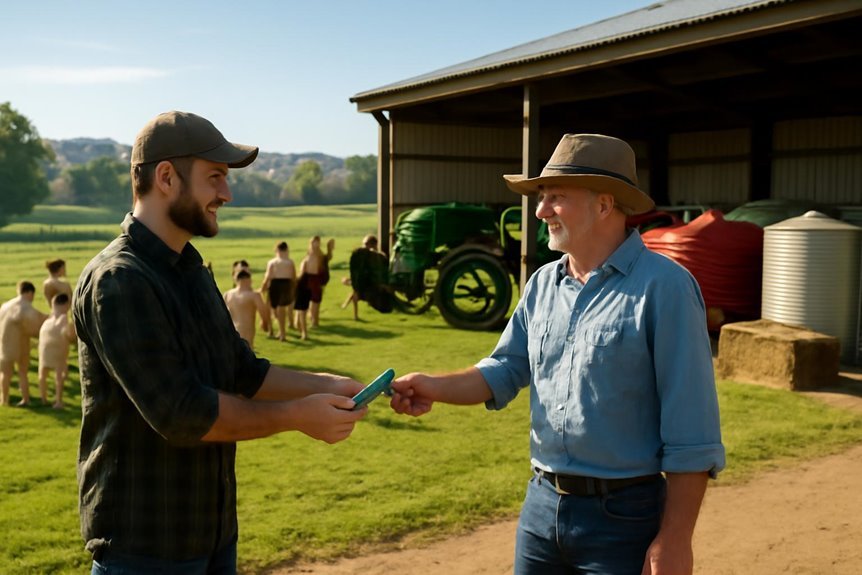Alpaca Farm Expenses: Top 10 Cost-Saving Tips
You can cut alpaca farm expenses by optimizing pasture management with rotational grazing and bulk hay purchases, plus providing consistent feeding routines. Preventive vet care and health monitoring keeps costly treatments at bay. Choose durable fencing like woven wire with electric support to lower repairs. Maintain shelters regularly for longevity and manage labor smartly through flexible staffing. Exploring grants and community partnerships can boost savings even more. Stick around to uncover additional ways to make your alpaca farming more cost-efficient.
Key Takeaways
- Implement rotational grazing and pasture maintenance to improve grass yield and reduce supplemental feed costs.
- Purchase hay and grains in bulk to benefit from 10-20% discounts on feed expenses.
- Regularly inspect and maintain shelters and fencing to prevent costly repairs and extend infrastructure lifespan.
- Collaborate with local farmers for group feed purchases and shared veterinary services to lower costs.
- Utilize strategic breeding and detailed record-keeping to enhance herd quality and reduce breeding-related expenses.
Optimize Pasture Management for Feeding Efficiency

Although managing pasture efficiently requires effort, adopting rotational grazing can boost grass health and yield by up to 30%, cutting your feed costs considerably. To optimize pasture management, implement rotational grazing techniques that allow grass to recover, improving feeding efficiency and preventing overgrazing. Regular pasture maintenance, costing about $50 to $200 per acre annually, supports long-term sustainability and further reduces feed costs. Supplementing with high-quality grass hay during winter guarantees your alpacas get consistent nutrition when pasture is scarce. Don’t forget camelid-specific mineral formulations to enhance nutrient intake and support regular health. Setting up your pasture with proper gates and walkways also facilitates smooth movement and feeding access. By applying these strategies, you’ll maintain a healthy pasture environment that sustains your alpacas’ nutritional needs while lowering overall feeding expenses.
Implement Preventive Veterinary Care
When you prioritize preventive veterinary care, you can avoid costly health problems and keep your alpacas thriving. Regular veterinary care, including routine health monitoring and vaccinations, is key to effective health management. By tracking vaccination records and adhering to schedules, you prevent disease outbreaks that could devastate your herd. Establish a relationship with a camelid-specialized veterinarian to get tailored preventive care advice and timely interventions, reducing unexpected veterinary expenses. Observing your alpacas daily for changes in behavior or appearance helps catch health issues early, saving you money on emergency treatments. Additionally, investing in health insurance policies for your alpacas offers financial protection against unforeseen medical costs. Together, these steps guarantee your alpacas stay healthy while keeping your farm expenses manageable.
Choose Durable and Low-Maintenance Fencing
You’ll save money by choosing fencing that’s both durable and low-maintenance, like woven wire or electric options. These materials not only last longer but also reduce the time and cost spent on repairs. Plus, proper fencing height and design can prevent escapes and protect your alpacas from predators, cutting down on unexpected expenses.
Cost-Effective Fencing Options
Choosing durable and low-maintenance fencing is key to keeping your alpacas safe without breaking the bank. Your costs include land and fencing materials, so opting for woven wire fencing, which costs $3 to $6 per linear foot, offers a balance of durability and safety. Adding electric fencing at $1 to $2 per foot can enhance security, especially for larger pastures. Selecting no-climb fencing designs helps reduce maintenance needs while protecting the safety of the alpacas by preventing injuries. Proper height, around 4 to 5 feet, is essential to keep alpacas contained. Regular inspection is another critical cost-saving tip, as it helps catch issues early, avoiding expensive repairs. By carefully choosing fencing types and designs, you guarantee long-term protection and cost efficiency.
Maintenance Reduction Strategies
Durable fencing not only protects your alpacas but also cuts down on maintenance time and costs. Choosing woven wire fencing offers a sturdy barrier that minimizes frequent repairs, even if it costs $3 to $6 per linear foot. Adding electric fencing—just $1 to $2 more per foot—boosts security by deterring predators and reducing escape risks, saving on livestock loss. No-climb fencing is another smart choice; its design lowers maintenance needs and operational costs over time. Proper installation with secure latches and inward-opening gates prevents damage and costly repairs. To maximize longevity and avoid unexpected expenses, regularly conduct inspections and maintenance. By investing upfront in durable, low-maintenance fencing, you’ll reduce ongoing repairs and operational costs, ultimately saving money on your alpaca farm.
Utilize Strategic Breeding Practices
When you apply strategic breeding practices on your alpaca farm, you can boost genetic diversity and fiber quality, which directly increases your herd’s market value and profitability. Choosing the right breeding stock and introducing young alpacas gradually helps lower initial costs while improving genetics. Utilize pen mating to control pairings, which promotes successful pregnancies and reduces expenses linked to unsuccessful breeding attempts. Keeping detailed records of breeding history and cria health allows you to make informed decisions, enhancing offspring quality. Timing breedings to align with ideal seasonal conditions supports better cria health and reduces stress on mothers, minimizing health issues and veterinary costs. These strategies collectively enhance herd health and fiber quality, making your alpaca farm more efficient and cost-effective in the long run.
Maintain Shelter to Extend Longevity

You’ll want to regularly inspect your alpaca shelters to catch small issues before they turn costly. Timely repairs and routine upkeep can save you from expensive replacements down the line. Keeping on top of shelter maintenance helps protect both your investment and your alpacas’ health.
Regular Shelter Inspections
Regular shelter inspections are essential for spotting early signs of wear and tear, letting you make timely repairs that extend your shelter’s life and save on costly replacements. By conducting regular shelter inspections, you can identify structural damage, poor ventilation, or drainage issues that lead to moisture buildup, which increases maintenance expenses. These preventative measures not only protect your shelter but also promote a clean environment, reducing the risk of disease and lowering veterinary care costs related to alpaca health. Checking fencing and shelter materials during inspections helps prevent escapes and injuries, cutting down long-term costs. Keeping your shelter well-maintained through regular inspections guarantees a safer, healthier space for your alpacas while saving money over time.
Timely Repairs and Upkeep
Although minor issues might seem insignificant at first, addressing them promptly can save you up to 20% on maintenance costs by preventing costly repairs later. Timely repairs, combined with regular inspections, are essential preventive measures that reduce upkeep costs and extend the longevity of shelter. Make sure to maintain proper ventilation to avoid moisture buildup, which can cause health issues in your alpacas and structural damage to buildings. Routine tasks like cleaning gutters and checking for leaks help spread capital expenses over time by increasing shelter lifespan by 10-15 years. Investing in durable materials initially can further minimize repair frequency and cut long-term maintenance expenses by up to 30%. Don’t overlook fencing upkeep either—it protects your herd and prevents costly replacements, keeping your alpaca farm running smoothly and cost-effectively.
Invest in Shared Equipment and Resources

When you team up with neighboring alpaca farms to share equipment and resources, you can cut costs considerably. Collaborating on shared equipment like shearing tools and feed mixers saves thousands upfront. Bulk feed purchases together reveal discounts, easing your yearly feeding budget. You can also lower health care costs by coordinating vet visits and accessing group rates. Community workshops foster shared knowledge, helping you avoid pricey training. Pooling funds for infrastructure projects like fencing further reduces expenses.
Here are some cost-saving tips to evaluate:
- Share shearing and feeding equipment
- Collaborate on bulk feed purchases
- Form cooperative agreements for veterinary services
- Attend community workshops for shared knowledge
- Pool resources for fencing and shelter infrastructure projects
This approach boosts savings and strengthens your farming community.
Practice Sustainable Feeding and Watering
You can save a lot by managing feed efficiently and conserving water on your alpaca farm. Rotational grazing and growing your own hay reduce feed costs, while automatic watering systems cut labor and prevent waste. Paying close attention to these areas helps keep your alpacas healthy and your expenses low.
Efficient Feed Management
Since feed costs make up a large portion of your alpaca farm expenses, managing feeding and watering efficiently is key to saving money. Efficient feed management guarantees your alpacas get proper nutrition without overspending. Alpaca feed costs can range from $300 to $800 annually per animal, so optimizing your approach helps control expenses.
- Establish a consistent feeding schedule using high-quality grass hay and supplements to reduce waste.
- Implement rotational grazing to promote pasture recovery and reduce reliance on purchased feed.
- Use bulk purchasing for hay and grains; discounts of 10-20% often apply.
- Provide fresh water constantly through an automatic watering system to maintain health and prevent feed spoilage.
- Regularly monitor alpaca weights to adjust feed amounts and avoid overfeeding.
Pair these steps with regular shearing to maintain overall herd health and cost efficiency.
Water Conservation Techniques
Managing feed efficiently sets a strong foundation for cost savings, but controlling water use can further reduce expenses on your alpaca farm. Practicing water conservation helps lower expenses related to water bills, which can range from $50 to $200 monthly depending on your herd size. Installing an automatic watering system guarantees your alpacas always have access to clean water while minimizing waste. You can also reduce monthly water expenses by harvesting rainwater and maintaining pipes and troughs to prevent leaks. Using energy-efficient equipment for water heating and delivery cuts electricity costs. Additionally, implementing rotational grazing boosts water retention in your soil, lessening the need for supplemental watering. Combining these techniques creates a sustainable feeding and watering routine that saves you money and supports your alpacas’ health.
Monitor and Control Labor Costs
Although labor costs can make up nearly half of your alpaca farm’s expenses, keeping them in check is essential for profitability. Effective management of labor costs helps you reduce overall operating expenses and maintain a healthy bottom line. You can control costs by strategically using part-time or seasonal workers during busy periods like shearing. Don’t overlook indirect labor costs such as payroll taxes and workers’ compensation, which add to your expenses. Employing flexible staffing arrangements and cross-training your team lets you optimize workforce utilization throughout the year.
- Use part-time or seasonal labor during peak times
- Offer competitive compensation to retain skilled staff
- Monitor indirect labor costs closely
- Implement flexible staffing arrangements
- Cross-train employees to maximize efficiency
Leverage Local Fiber Processing Partnerships
When you partner with local fiber processing mills, you can considerably cut your processing costs and improve your farm’s profitability. Working with nearby processing facilities helps reduce processing costs by lowering transportation expenses and securing better rates, especially for small-scale local alpaca farms. Utilizing community fiber processing options also boosts operational efficiency through shared resources and bulk discounts. Plus, close collaboration guarantees better quality control of your fiber products and adherence to sustainability practices, which appeals to eco-conscious buyers. By fostering strong relationships with local artisans and mills, you not only enhance product value but also support a sustainable, community-focused approach. Embracing these partnerships makes your alpaca farm more efficient and profitable while contributing positively to the local fiber industry.
Explore Financial Assistance and Grants
If you want to reduce the financial burden of running your alpaca farm, exploring available financial assistance and grants is a smart move. Various programs, including those from the USDA, support sustainable agriculture and can provide grants tailored for alpaca farms. Local agricultural extension offices are great resources for up-to-date information on funding opportunities. Additionally, nonprofit organizations often sponsor grants that promote innovation in alpaca farming. You can also boost your income by engaging in community-supported agriculture (CSA), which builds a local customer base through pre-paid subscriptions.
- Check USDA grants focused on sustainable agriculture and alpaca fiber production
- Consult your local agricultural extension for targeted financial assistance
- Apply for grants from nonprofit organizations supporting alpaca farms
- Explore community-supported agriculture programs for steady cash flow
- Monitor agricultural associations for special funding opportunities
Frequently Asked Questions
How Much Does It Cost to Run an Alpaca Farm?
Running an alpaca farm involves initial startup costs like fencing, shelter construction, plus ongoing expenses for feed and nutrition, veterinary care, shearing costs, insurance, and marketing strategies. You’ll need to budget carefully to manage these expenses effectively.
What Are the Disadvantages of Raising Alpacas?
You’ll face breeding challenges since alpacas have an 11.5-month gestation, plus high initial investment, space requirements, feeding costs, behavioral traits, health issues, fiber processing complexity, and fluctuating market demand can make raising alpacas tough.
How Many Acres for 10 Alpacas?
You’ll need about 1.5 to 2 acres for 10 alpacas to meet acreage requirements, ensuring enough grazing space. Proper pasture management, considering herd dynamics, land utilization, zoning regulations, environmental impact, and feed availability, is essential for their health.
How High Maintenance Are Alpacas?
You’d think alpacas need a king’s ransom, but their grooming, feeding, health care, shelter, social needs, breeding, and behavior are surprisingly low-maintenance compared to other livestock—making them easier and cheaper to raise than you might expect.







Our picks
Alpaca & Wool Felted Sole Inserts: Comfy Upgrade?
Best Alpaca Socks for Hiking: Ultimate Comfort and Durability on Trails
Best Alpaca Halter for Comfort and Control